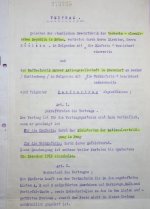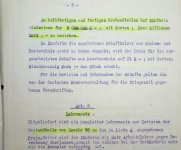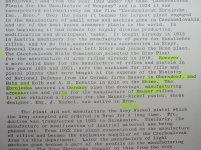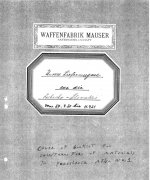The arsenals didn't get sent anywhere, - they were rolled-over into state owned corporations (private fronts in some cases, but stock held by the government). The Entente allowed the various “Government owned” facilities to continue under certain circumstances (originally it was planned to close them all and destroy them), largely because of unemployment concerns-, which was, in part, fueling the unrest in Germany.
They were all de-militarized between 1920-1923, all war industries- whether private or state owned. To operate in post-Versailles Germany you had to go through an inspection and be certified, (some more rigorous than others- The previous State Arsenals were highly scrutinized and modified by the IAMCC. Krupp had in-house British supervision till 1926, long after everyone else). Essentially machines were classified into 3 categories, - machines of civilian use, machines of dual purpose and machines with only a military purpose.
Machines in the first class were kept in most cases, machines in the second class were allowed to an extent, depending on the firms planned production, those machines in excess of what the IAMCC thought practical were “usually” allowed to be sold to other firms- domestically and to other countries.
Machines in the last category were the real issue, in most cases the machines were destroyed under supervision of the IAMCC and sent to scrap facilities also monitored by the IAMCC.
The idea behind Versailles was not to distribute Germany’s war making ability throughout the world, making a hundred little Germany’s, but rather to create a lasting peace by destroying Germany’s war capability. (of course ideas and reality are two different things- for the most part Britain got what she wanted, most of the German equipment was destroyed rather than sold to countries friendly to France, which is what France wanted)
As for the cases where machines in the 3rd category were distributed by “reparations” or sold:
1. Before Versailles came into effect Mauser Oberndorf sold machines and parts to the Czechs, this was totally legal and went through (Czechs were never given reparations from Germany- during the war they were part of Austro-Hungarian Empire, hardly a victim of Germany- they did try to get “reparations” from Austria and Steyr with some success).
2. Simson was allowed to buy some machines from Erfurt, but no other sales were allowed besides a small ammunition sale to the Czechs.
3. As for “reparations” to Poland and the Arsenal at Danzig, - Poland received some machines from the old Danzig facility to start up Warsawa, but this was not “reparations” as Poland did not get reparations. Not even private property in Poland was lost to German companies. Poland did threaten nationalization of many “German owned” steel / mining companies but the German owned firms fought this off by a combination of inviting US companies to share ownership and taking on Polish management. Poland’s rifles came from many places (a hodgepodge really) facilities, depots in areas that passed from Germany to Poland, disarmed German soldiers in their area, and purchases from France, Belgium and the Dutch.
4. Yugoslavia was compensated for the destruction of their facilities by some machines from an unnamed State owned Arsenal (some say Spandau and this is most likely imo). Some say it was Mauser Oberndorf, and this is possible but not without compensation (they probably sent machines ordered by the Reichstreuhandgesellschaft but they would have been compensated by the government- possibly machines not available at Spandau who had really moved away from rifle production by 1918).
Generally private firms were not forced to pay reparations directly, - the German government was the only institution held liable for war damages, - the only exception being stolen machines and assets in Alsace-Lorraine, which I believe, had to be written off by the German steel/mining companies.
During the war the German Army seized machines in occupied territory (Belgium the largest victim), they then sold the machines to German companies and the IAMCC did not care what the circumstances were behind the theft/purchase.
The classic case was with DWM, they owned controlling stock at FN before the war. Once the German Army occupied FN, they refused to do war work, so the German Army sent the machines to Spandau. Where the machine gun tooling was used to expand MG08 production. They used FN’s rifle tooling as their part in the creation of WOK/Oberspree (it was joint venture- DWM and the government- typical of governments, they used stolen machines for their part, in this case stolen from their partner!). Late in the war DWM bought out the government, and when the war ended, Belgium demanded its machines back!
It didn’t matter that DWM actually owned a majority holding at FN, that they had purchased their own machines from the German government, - the machines had to be returned, and they were.
The only thing that could make it worse for DWM, was for the Belgian government to seize their stock holdings in FN. Guess what- they did!
Anyway, the Versailles treaty never really changed things fundamentally, the firms were all de-militarized and superficially altered, but not to an extent that would prevent their re-creation if that was desired. The simple fact is that the Entente couldn’t prevent, short of perpetual occupation, Germany re-arming eventually as Germany possessed the thing they couldn’t destroy.
A highly skilled work force, and the industrial base to manufacture in the US developed style of component assembly. This is what Germany did in WWII, they used a system based upon the US method- sub-contractors making components for weapon systems and assembled at firms designed for the purpose. (Gustloff Werke Weimar a perfect example of the “rings” at work).
The days of the huge State Arsenals were over, - the Eli Whitney, P&W, B&S, and L.Loewe revolution was here! – combined with banking of course…
Lastly, the MRJ has done articles on all the State Arsenals (Erfurt and Danzig will be re-done and expanded in the template used for Spandau & Amberg) and the next one up is on Ludwig Loewe & Co AG / DWM. It was the most challenging of them all but I think we will have it done by the next issue.




